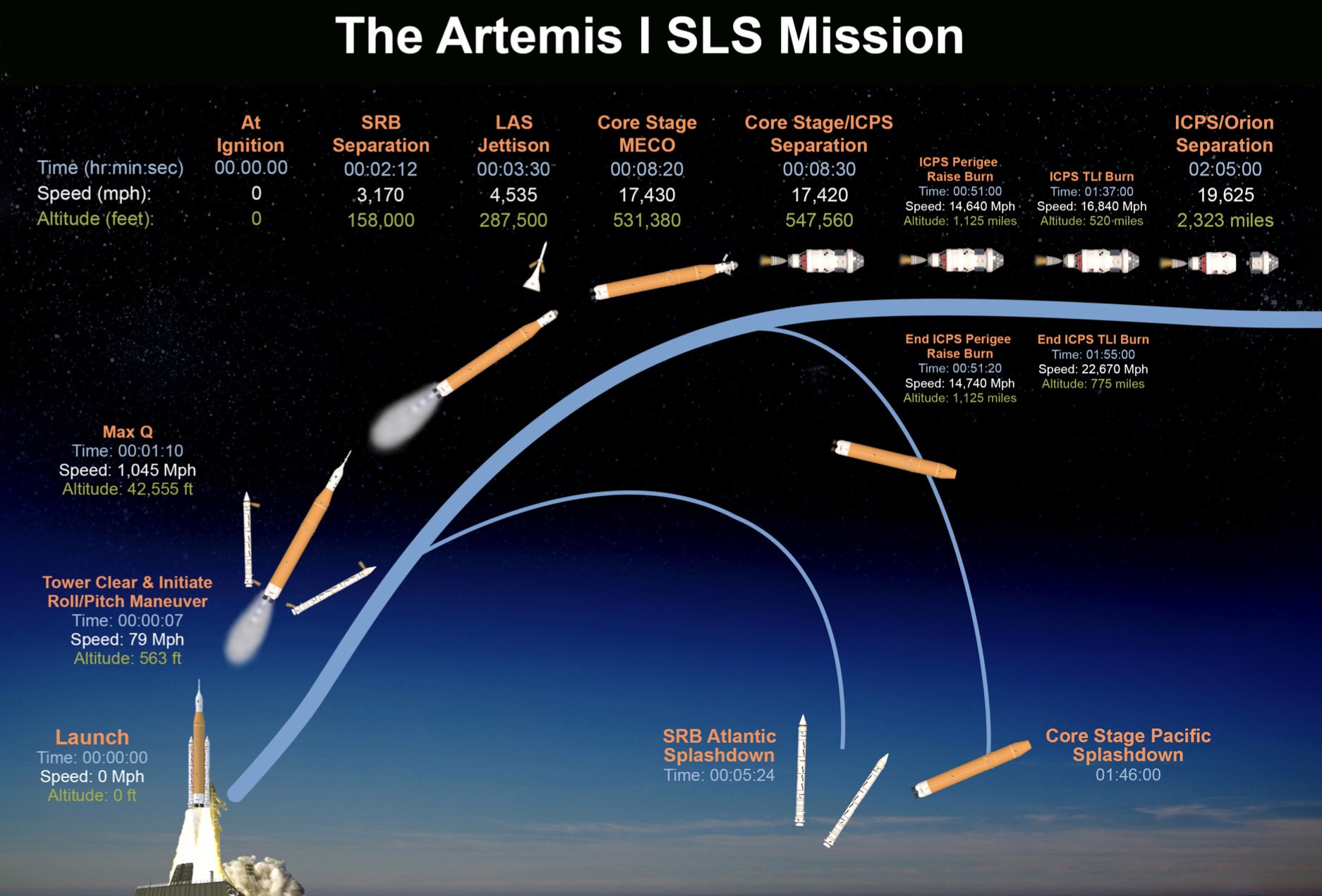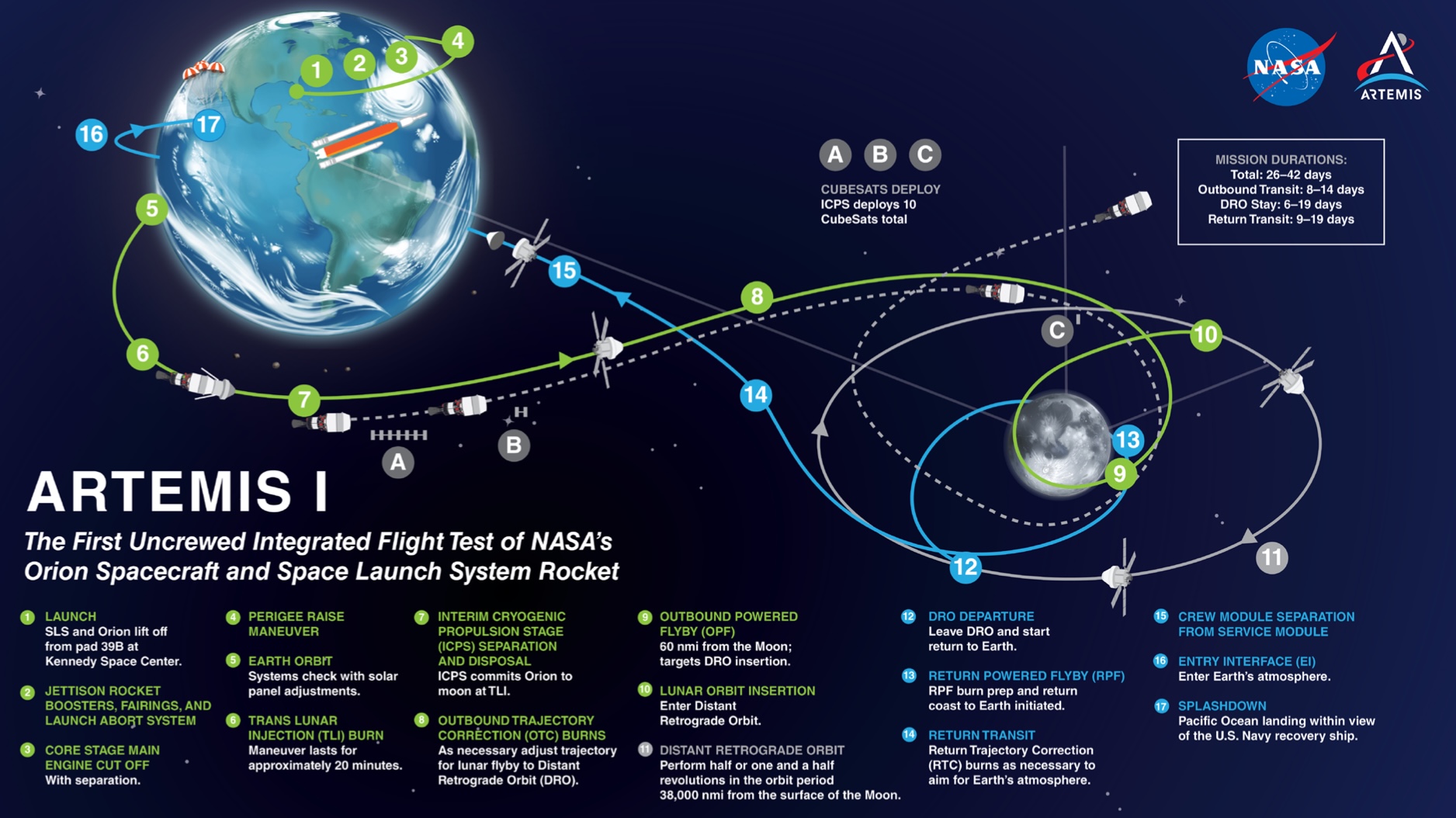
download player
At 7:47 (1:47 in Florida), NASA’s Artemis 1 mission departed for the moon, nearly three months behind the launch date, originally set for last August 29. The test is essential for piloting the massive Space Launch System (SLS) rocket, which lifts as high as a 30-story building, and the Orion transport capsule, whose crews will one day go to the Moon. It is the most important space mission in recent years for the United States, which is working with other space agencies such as the European Space Agency on the new Artemis program to create an orbital lunar base and experiment with technologies that may one day allow us to reach. Mars.
The launch was initially scheduled for 7:04 (1:04 in Florida), but around 6 a.m., technicians had to intervene to resolve a malfunction in one of the ground systems related to the missile’s safety controls, which accumulated after about 40 minutes. . At 7:47 the mission finally departed and in the next few days it will reach the Moon and then return to Earth.
Artemis 1 launch live coverage
This past August 29, NASA had to waiver When launching Artemis 1 due to a problem with the refueling system of the first stage of the rocket, which was at that time reintroduced On 3 September, when a new departure was attempted. Later, it was necessary to move the SLS from the launch pad to the Vehicle Assembly Building (VAB), the large building where the missile is assembled and configured.
After some maintenance activities, the SLS was returned to the launch pad on November 4 and in the following days had to contend with strong winds from Nicole, the tropical storm that affected Florida and part of the southeastern United States. Returning the rocket to the VAB to rescue it from the storm’s fierce gusts would have further delayed the launch, which is why NASA technicians preferred not to change plans, even though they knew they had to do so. You face more risks associated with Nicole.
After the storm passed, NASA delayed November 14 and 16 for a few days and then ran checks around the rocket to ensure its systems were not damaged. At the end of the checks at the start of the week were the directors of the space agency Given Their green light to continue with the necessary procedures to prepare for launch. Inspections identified some minor damage, but no compromise to the missile’s function and overall launch safety.

SLS on the launch pad in Cape Canaveral, Florida, USA (Red Huber/Getty Images)
The SLS is similar to some parts of the launch system of the shuttles, Spaceships that left vertically and returned to land like an airplane. In fact, the new system is a derivation of different technologies already developed for the shuttles: its central body, i.e. the first stage (core stage), resembles the large orange tank to which the shuttles were connected at the moment of departure and from which they drew fuel to run their engines.
The SLS uses the same Shuttles motors, which are connected directly to the Core Stage base, but it’s not the only one. In the initial stages of launch, on either side of the first stage are two smaller rockets (Solid Rocket Booster, SRB), necessary to give the initial thrust to the entire SLS nearly 100 meters high, to detach it from the launch pad.

Space Shuttle Discovery vs. SLS (NASA)
SRBs are 15 stories tall and contain a propellant made of ammonium perchlorate and acrylonitrile polybutadiene, which results in a very fast reaction. Each booster burns about six tons of propellant every second, providing thrust equal to that produced by 14 large passenger airliners (such as the Boeing 747). On the other hand, the core stage uses liquid hydrogen and liquid oxygen to power its four engines.
At the top of the core stage, an upper stage is installed, equipped with one engine, above it is an actual spacecraft called Orion, consisting of two units: the service unit, the crew unit, in which one day there will be Artemis astronauts and cosmonauts, still at the helm All system abandon at all. Carrying tons of material into orbit requires a large expenditure of energy, so the best strategy is to make your spacecraft progressively lighter as it goes up, so that you can push its mass more easily.

(NASA)
At 0747, the SLS fired its engines and lifted off the ground, accelerating rapidly despite its 2,600 gross tons of mass. Within two minutes, he reached an altitude of 48 thousand meters, the height at which the two SRBs, having finished their mission and becoming useless ballast, separated. It was wrecked in the Atlantic Ocean, from where it will never be recovered.
we are going.
for the first time , @employee missile f @employee fly together. # Artemis I begin a new chapter in human exploration of the moon. pic.twitter.com/vmC64Qgft9
– NASA (@NASA) November 16, 2022
The remainder of the rocket continued its ascent, propelled by the four engines at the base of the primary stage for another six minutes. At that point, even the larger stage ran out of fuel and moved 170 kilometers away from Earth, ending up a few minutes later in the Pacific Ocean.
From the SLS in space the upper stage remained connected to Gurion. After a short period in orbit around the Earth, it will activate its engines to put the vehicle on the right path towards the Moon, which is an average of 380,000 km away from us.
Two hours after launch, Orion will separate from the remaining segment of the SLS and continue its journey toward our natural satellite. In addition to the separation, the SLS upper stage will launch ten small satellites (CubeSats) that will be used to perform various experiments. Among those, there will also be ArgoMoon, a satellite built by the Italian aerospace company Argotec on behalf of the Italian Space Agency (ASI), which will monitor upper-stage conditions.

Orion’s trip to the moon will last about ten days and technicians will monitor it to gather important data about the vehicle’s behavior, which will prove very useful in organizing future manned missions. Orion will then fly by just under 100 kilometers from the lunar surface, later using the force of gravity to enter a “retrograde” orbit. In practice, the spacecraft will begin to rotate in the opposite direction of the Moon’s rotation. Orion will reach a distance of 64,000 km behind the moon, setting a new record compared to the previous one by about 16,000 km, which was achieved with Apollo 13, the mission that was unable to land on the moon due to a technical problem.
After a few days in lunar orbit, Orion will start the engines to exit and resume the journey to Earth. Near our planet it will ditch the Service Module, it will point its heat shield towards the planet and it will begin to enter the atmosphere, thus protecting itself from the high temperatures that will occur at that point. Finally, it will open its parachutes and end the flight in the Pacific Ocean, where rescue teams will handle the recovery process.

Generally, the job should last 25 days, but times may vary. After the various delays, NASA is confident that it may be the right time to approve the first significant success of the Artemis program, which has had a long and complex gestation period, mainly due to the significant delays accumulated in the development of the SLS. The rocket was supposed to make its first flight in 2016, but things turned out differently, as tens of billions of dollars were spent more than expected.
If Artemis 1 is indeed successful, in the coming years the Artemis 2 mission will repeat the same activities, but with a crew of four aboard Orion. The actual moon landing is not expected before 2025 (new delays are likely), as the first astronaut and first non-white astronaut walk on lunar soil.
In orbit around the moon will also be built Moon Gate, which is an orbital base much smaller than the Earth-orbiting International Space Station. It will be used to house crews and other instruments and to dock Orion and other spacecraft, including those that will physically bring astronauts to the moon, a goal that is not a secondary goal and that there are still many uncertainties about.

Virtual configuration of the Lunar Gateway, in computer mode (NASA)
So far, the Artemis program does not have a landing system. On the Apollo missions, the lander module (LEM) was flown from Earth to the Moon along with the rest of the hardware; On the other hand, Orion travels without vehicles to land on the moon. NASA has entrusted Elon Musk’s private space company, SpaceX, with the task of providing the move, with a nearly $3 billion contract to make its Starship spacecraft compatible with lunar activities.
Starship has long been under development at the large launch base in Texas where SpaceX has focused most of its activities, but it has never reached Earth orbit. Musk has repeatedly made optimistic predictions about the first orbital flight, but so far the system is being tested and has accumulated some delays. However, in the future Starship could become a much more practical and cheaper way to get to the moon than the SLS.

(spacex)
The SpaceX spacecraft is actually designed to do everything on its own: from Earth, to travel to the moon, to land on the moon and back. It’s also reusable, so it could make trips to the moon much cheaper, but it’s not yet proven that it works. A simplified version will be used for the first Artemis missions, to handle only crew transfers from the future Gateway in lunar orbit to the Moon.
The last manned mission to the Moon dates back to December 1972, when Apollo 17 landed with American astronauts Eugene Cernan and Harrison Schmidt. Fifty years later, it’s not clear how much Cernan, who died in 2017, will continue to be.The last man to walk on the moon.